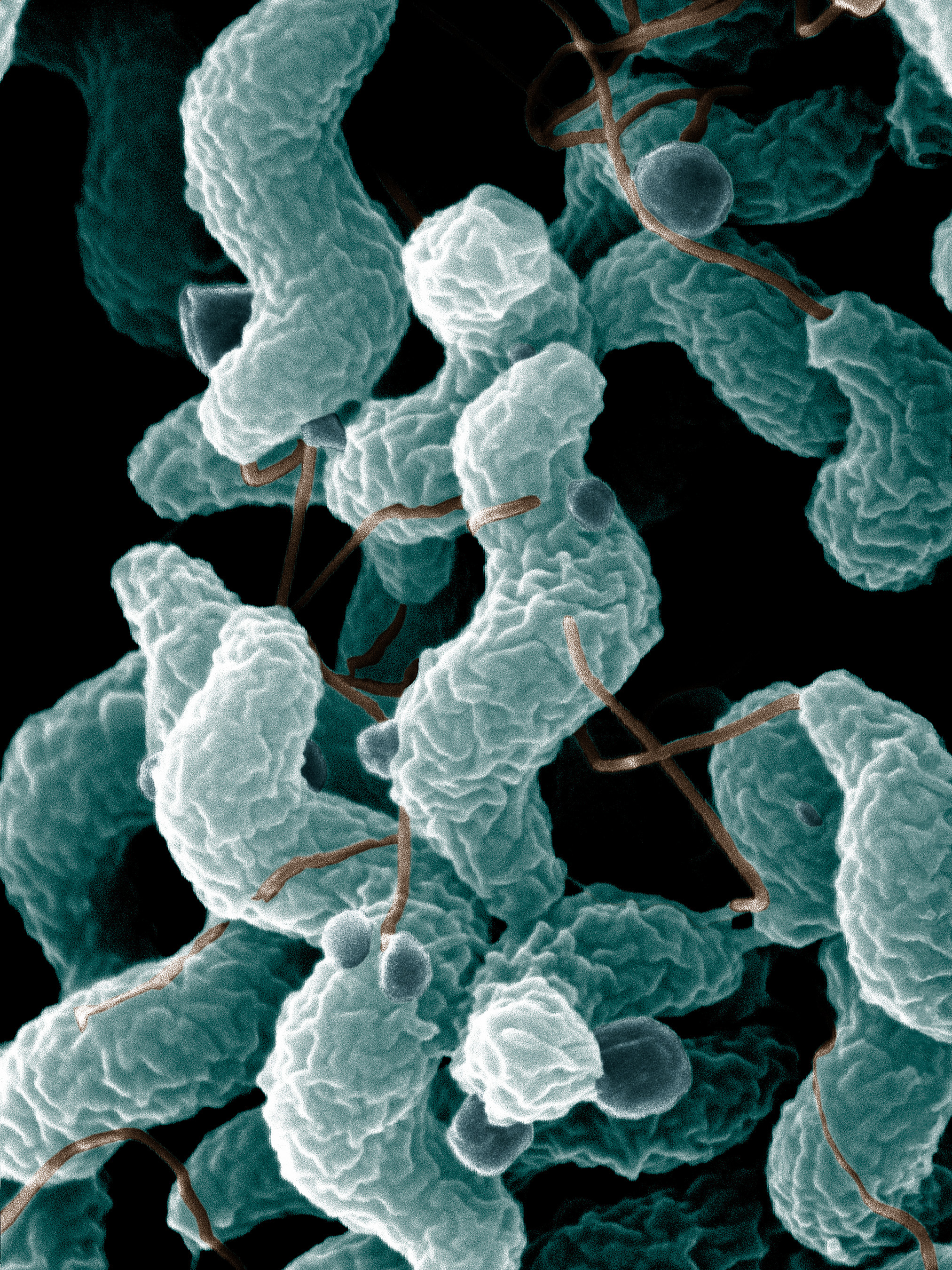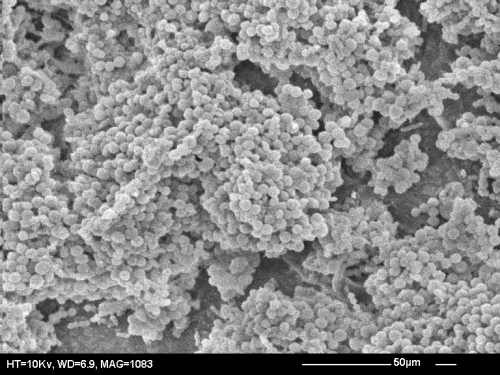July 25, 2014, by Brigitte Nerlich
Thinking with animals: The microbe
This is a GUEST POST by Richard Helliwell, a PhD student at the Institute for Science and Society, who participated in a workshop on Thinking with Animals at the University of Nottingham on 20th June 2014.
What does it mean to think with animals, in particular to think with microbes, my ‘animal’ companion of thought? Firstly how do we think about microbes? When we think about the microbe, what often comes to mind is the humble bacterium, most often associated with disease, unhygienic conditions, or food contamination, it is the dangerous other. Indeed an industry has grown devoted to excluding bacteria from certain spaces of human habitation. 99.9% has become their mantra. However, more mundane associations exist. Yakult is full of a specific species of ‘friendly’ bacteria to keep us healthy, whereas blue cheese is riddled with bacteria to create its unique and I might add delicious flavour. However, what exists in all these examples is the illusion of control, that we allow and remove bacteria at will. We use biocides to quite literally wipe bacteria out of specific spaces, we use antibiotics to destroy pathogenic bacteria that cause clinical manifestations of disease, and we select specific strains, and culture them in controlled environments to create blue cheese or Yakult. Yet with the microbe, human agency, the choice of which animals to ‘live with’, as Donna Haraway puts it, is entirely out of our hands. Microbes are the companion species that at some point in the past we made a pact that we must forever fulfil. They colonise our bodies whether we like it or not and are indeed crucial to its continued ability to function. We co-exist, co-evolve and are co-constituted with bacteria in an intimate and messy mingling in which we become entwined from the moment of birth to our (sometimes untimely) death. As James Lovelock astutely observes “the cuddly animals, the wild flowers, and the people are to be revered, but they would be as nothing were it not for the vast infrastructure of the microbes” (Lovelock, 1995, p. xix).
Life, the universe and bacteria
Bacteria provide, and provided, the environment in which different types of organisms can exist (Smil, 2002). It should be no surprise that the efforts to find life within our solar system have focused on bacteria. Yet this infrastructure imaginary, the microbial building block, once more only captures a fragment, an important fragment mind, of the greater mosaic. Scott Gilbert elucidates our embeddednes further: “the formation of an “individual” is actually the formation and continuity of a collegial assemblage of organisms” (2002, p. 211).
To think with the microbe therefore requires us to re-imagine the human as a co-constituted being, an assemblage, but within this assemblage we are both the organism and the environment. A continuity of the false distinction we make between human and environment. Our bodies are packed with commensal and symbiotic microbes, concentrated within the gut but also on the skin and in the nose to give but a few examples. Indeed, when thinking with the microbe (and the microbiome), it requires us to go one step further, acknowledge that perhaps we are the stooge. For when becoming the organism and environment it still suggests that those roles can be separate, I can differentiate between the spaces of the body that are ‘me’ and those that are the environment for the bacterial other. In pulling this figurative trick it allows me space to claim the title of ‘organism’ principally for myself, providing the bacteria with the position of entourage. However, can I make that claim with any certainty?
“when the physiologist J.B.S. Haldane once commented that even the Archbishop of Canterbury is 65% water (Clark, 1984), he omitted to mention that the head of the Church of England also consists of more bacterial cells than eukaryotic cells and that the combined number of genes in these bacteria exceeds the total number of eukaryotic genes by a factor of at least 100.” (Macpherson & Harris, 2004 p. 478)
Outnumbered
Within our own bodies we are outnumbered, and genetically outgunned by commensal bacteria. Equally this is all the while assuming a passive co-existence. But is passivity the name of the game? Indeed if we are the stooges it would not be the first time that a microbe is able to co-opt an ‘organism’ to fulfil its requirement for survival and propagation. The Ophiocordyceps unilateralis fungus, or zombie ant fungus, is just a single dramatic example of how the presence of microbes within the body shapes the macro-organisms behaviour.
Therefore do we presume too much when we cast bacteria as passive, as environmental freeloaders within our guts? Bacteria have rudimentary intelligence and intent, it increasingly seems that their banner as the simplest form of life is actually based on our simple knowledge of how they live. Many bacteria rarely live as isolates for long. They survive within a structure called a biofilm (Fig. 1). Biofilms are coordinated and cooperative multi-cellular communities, equivalent to multicellular organisms (Nadell, Xavier & Foster, 2009). These communities have sophisticated communication networks enabling decisions about cell differentiation and gene expression to divide labour allowing greater exploitation of resources, and collective defence capacities (Shapiro, 1998, Crespi, 2001) as well as coordinated dispersal to facilitate the colonisation of new locals (Allison et al, 1999). Pointing to a rudimentarily form of decentralised intelligence that is able to process externally and internally gathered information and make genetic and community decisions in response (Hellingwerf, 2005).
Figure 1: A bacteria biofilm within an oral wound. (Malic et al, 2007)
Communication
In particular quorum sensing is an important mechanism of communication allowing assessment of internal biofilm characteristics (local density of bacterial population) and external environmental conditions (flow of nutrients), as well as enabling coordinated dispersal (Allison et al, 1999). On its own quorum sensing opens up important avenues of thought with regards to the decentralised nature of intelligence and action within a macro-community of cells, such as a human. Equally what does this mean for political thought as it braces itself to enter a multi-polar world. For the microbe this intelligence and cooperative action, the result of decentralised interactions, takes place between organisms of the same and different species! Furthermore what does it mean for us as ‘humans’ when it becomes apparent that this coordination, cooperation and communication does not end with the bacterial community. These communicating, intelligent biofilms of bacterial cells that colonise our gastrointestinal tract interact with the specialised eukaryote cells of the intestines, alongside the human immune system with far-reaching effects, shaping it and us throughout our lives (Macpherson & Harris, 2004). This alludes to the co-evolution of bacteria and humans, both shaping and re-shaping each other. Human agency and bacterial agency meet and are forced to find a middle ground. Indeed it is important to note that the human gut in particular is colonised by a large variety of different bacteria species but most importantly strains. Many of which are specific to human beings and are unable to survive for long outside of the human body.
Therefore this whistle stop tour of thinking with microbes opens up epistemological possibilities that enable the logical transcendence of dichotomous thought; nature vs culture, and human vs non-human become difficult to maintain in the face of co-evolutionary systems that allude to a socio-evolutionary nature of messy assemblages of organisms. As well as ontological questions about what it is to be an assemblage of organisms and does the decentralised qualities of such an assemblage open up new possibilities for enquiry. Perhaps when Annemarie Mol coined the title The Body Multiple, she touched on a greater reality.
References
Allison, D.G., Heys, S.J.D., Willcock, L., Holah, J., and Gilbert, P., (1999). Cellular detachment and dispersal from bacterial biofilms: a role for quorum sensing?, pg. 279–293: In, Wimpenny, J.W.T., Gilbert, P., Walkter, J.T., Brading, M.E., and Bayston, R., (eds.) Biofilms: The Good, the Bad and the Ugly. Bioline, Cardiff.
Clark, R.W., (1984). The life and work of J.B.S. Haldane, Oxford University Press, Oxford
Crespi, B.J., (2001). The evolution of social behaviour in microorganism, TRENDS in Ecology and Evolution, Vool. 16(4), pg. 178-183.
Hellingwerf, K.J., (2005). Bacterial observations: a rudimentary form of intelligence? TRENDS in Microbiology, Vol. 13, pg. 152-158.
Lovelock, J., (1995). The Ages of Gaia: A Biography of Our Living Earth. Oxford University Press, Oxford.
Macpherson, A.J., and Harris, N.L., 2004, Interactions between commensal bacteria and the immune system, Nature Reviews Immunology, Vol. 4, pg. 478-485.
Malic, S., Hill, K.E., Ralphs, J.R., Hayes, A., Thomas, D.W., Potts, A.J., and Williams, D.W., (2007). Characterisation of Candida albicans infection of an in vitro oral epithelial model using confocal laser scanning microscopy. Oral Microbiology Immunology, Vol. 22, pg. 188-194
Nadal, C.D., Xavier, J.B., and Foster, K.R., (2009). The socio-biology of biofilms, FEMS Microbiology Reviews, Vol. 23(1), pg. 206-224
Smil, V., (2002). The Earth’s Biosphere: Evolution, Dynamics, and Change. MIT Press, Cambridge.
Shapiro, J.A., (1998). Thinking about bacterial populations as multicellular organisms. Annual Review of Microbiology, Vol. 53, pg. 81-104.
No comments yet, fill out a comment to be the first



Leave a Reply